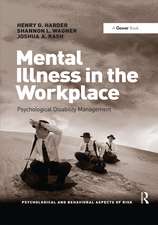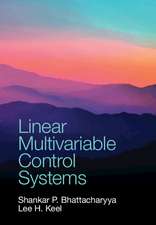Trapping Safety into Rules: How Desirable or Avoidable is Proceduralization?
Autor Mathilde Bourrier Editat de Corinne Biederen Limba Engleză Hardback – 20 feb 2013
Preț: 1117.07 lei
Preț vechi: 1362.29 lei
-18% Nou
Puncte Express: 1676
Preț estimativ în valută:
213.75€ • 223.17$ • 176.91£
213.75€ • 223.17$ • 176.91£
Carte tipărită la comandă
Livrare economică 05-19 aprilie
Preluare comenzi: 021 569.72.76
Specificații
ISBN-13: 9781409452263
ISBN-10: 1409452263
Pagini: 302
Ilustrații: Includes 13 b&w illustrations
Dimensiuni: 156 x 234 x 25 mm
Greutate: 0.68 kg
Ediția:New ed
Editura: CRC Press
Colecția CRC Press
ISBN-10: 1409452263
Pagini: 302
Ilustrații: Includes 13 b&w illustrations
Dimensiuni: 156 x 234 x 25 mm
Greutate: 0.68 kg
Ediția:New ed
Editura: CRC Press
Colecția CRC Press
Notă biografică
Corinne Bieder graduated as an engineer from the Ecole Nationale Supérieure de Techniques Avancées (1993). She then completed her education with master degrees in both risk management at the Ecole Centrale Paris (1994) and social sciences in La Sorbonne University (1999). She started her career doing research for Electricité de France on Human Reliability Analysis in the nuclear industry actively participating in the development and deployment of the MERMOS method (1994-2000). She then joined a small consulting company, named Dédale, to work on a variety of human factors and safety projects in a variety of hazardous domains (aviation, energy, railways, hospitals, etc). In 2005 she joined Airbus where she successively held jobs in the training and strategy departments. She is now with the safety department in charge on the corporate safety strategy. Corinne has published a book with Hermès-Lavoisier on human factors in risk management and a number of conference papers on human factors and safety. Mathilde Bourrier holds a PhD in Sociology from the Institut d'Etudes Politiques de Paris (1996) and an Habilitation (2004). She is Professor of Sociology at the University of Geneva. Mathilde works on the social construction of safety, focusing on the conditions under which organizational reliability can be achieved and sustained. Her research interests address risk and organization theory and organizational anthropology. She has conducted extensive studies at nuclear power plants in France and in the US and has also worked in public hospitals, looking at skills and know-how transmission in Anaesthesiology. Mathilde has published four books: one with the Presses Universitaires de France, on a comparative ethnography of Nuclear Power Plants in France and in the US (1999), the second with L'Harmattan, on Organizing Reliability (2001; 2003); She co-directed a volume for Cambridge University Press with Michael Baram on Governing Risk in Genetically Modified Agriculture (
Recenzii
’Procedures are by some seen as a panacea for all safety problems, while others realise that they are a double-edged solution that hinders as much as it helps. The book provides a refreshing analysis of the basic practical and theoretical issues, and is a valuable reference for people who recognise the difference between working to rule and working safely.’ Erik Hollnagel, University of Southern Denmark, Denmark ’This collection should be required reading for those who design and implement procedural strategies for managing risk across a broad range of complex socio-technical activities. The essays make a major contribution to our understanding of how overly detailed and specific procedural rules may raise new problems and risks as their volume and formalization increase, limiting discretion and impeding learning from mistakes or errors.’ Professor Emeritus Gene Rochlin, University of California, Berkeley, USA ’If you are involved in the development and implementation of procedures, this is a book to read. It is not a guideline how to deal with the problem of realising safety and proceduralization. It provides an overview of the history of the development of procedures, the interaction of culture with procedures, and some of the effects procedures can have on the execution of tasks and the realisation of safety. As such it is a major contribution in understanding the delicate relationship between rules and procedures, the development of expertise, and the contribution of this to safety.’ Newsletter of the Europe Chapter of the Human Factors and Ergonomics Society, no. 2 / 2013 ’Overall then, Trapping Safety into Rules makes an important contribution to the field of safety science and area of procedures and safety management. I would recommend it to those researchers and practitioners working in the areas of safety management, procedure development and assessment, accident causation analysis, and also to those working in the broader areas of safety c
Cuprins
List of Figures, List of Tables, List of Contributors, Preface, Trapping Safety into rules: an introduction, Part I Where Do We Stand on The Bureaucratic Path, Towards Safety?, Part II Contrasting Approaches To Safety Rules, Part III Practical Attempts To Reach Beyond, Proceduralization The magic Tools Illusion, Part IV Standing Back To Move forward, Index
Descriere
Once safety is involved, there seems to be an irresistible push towards more norms, procedures and processes, whatever the context. This book is not a plea against proceduralization, but it does take the view that it is time to reassess how far it can still go and to what benefit. There is a growing suspicion that the path taken might in fact lead to a dead end, unless the concept of procedure and the conditions under which procedures develop are revisited.
























